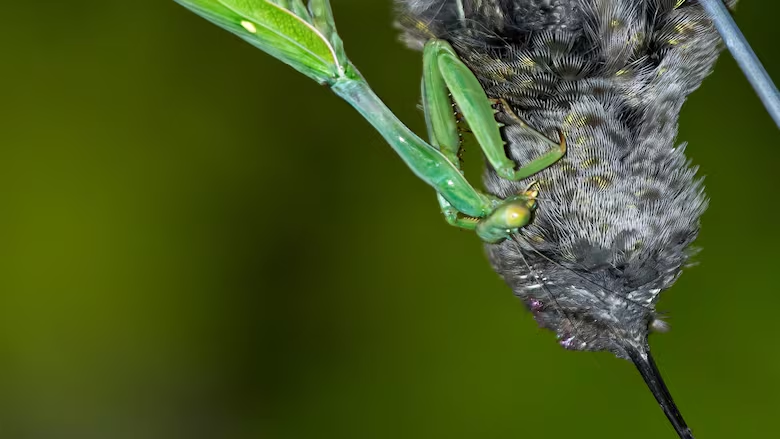Hummingbirds beware: Study documents praying mantises killing, eating birds
Researcher calls findings 'spectacular discovery'

They blend in with their leafy surroundings, strike with lightning speed and eat the brains of small birds — and they're only about nine centimetres long.
Researchers from the University of Basel have documented dozens of cases, over nearly 100 years, of praying mantises feeding on small birds. And while they're not fussy eaters, they seem to be partial to hummingbirds.
The cases span 13 countries — including Canada — and have occurred on all continents except Antarctica.
The researchers scoured various sources, obtaining their data from reports on bird predation by online sources, as well as Thomson-Reuters archives and peer-reviewed literature.
In all, they found 147 reports of praying mantises trying to prey upon smaller birds. They found that 12 different species of mantids killed and ate 24 different species of birds, including seven species of hummingbirds.
The new findings, published in the Wilson Journal of Ornithology, paint an even more ghastly picture of the praying mantis — an insect best known for the fact that the females kill their partners after mating.

The researchers can't say whether this behaviour is on the rise, but they do think people are partly to blame.
That's because we attract hummingbirds to gardens by planting the nectar sources they seek, and at the same time release mantids such as the praying mantis into gardens for pest control.
"Thus, humans bring these two together in an unnatural manner," Martin Nyffeler, co-author of the paper and and professor of zoology at the University of Basel, told CBC News in an email.
Diet of the mantis
As for what the praying mantises were consuming of the birds, it was a bit gruesome.
"About two-thirds of the birds were bitten into the head, neck or throat. In several cases, a mantid had chewed a hole in the victim's head and was extracting its brains," Nyffeler said. "Occasionally birds were scalped or decapitated, and in some cases they were de-feathered by their captors."
- Parasite forces bird lovers to put away feeders for summer
- Climate change threatening some migratory birds that breed in Canada
- Insecticide found in same B.C. hummingbirds that are in decline
Sometimes, the entire bird was consumed, while other times it was a small portion — likely dependant on how hungry the mantis was, Nyffeler said.
There has only been one documented case in Canada — in the Hamilton, Ont., area.
Praying mantises usually feed on insects like butterflies, honey bees, flies and spiders. Occasionally they've been found to feed on small vertebrates, such as frogs, lizards and snakes. The researchers don't know why some have been found to feed on small birds.
Waiting game
Mantids typically ambush their prey: camouflaged by foliage, they strike out and grasp their unsuspecting meal with their two front legs, while holding onto a leaf or grass with their four back legs. Then, while their food is still alive, they begin their feast. There is no poison involved.

The researchers are fairly certain the mantids are killing the prey and not just scavenging.
It is the nature of mantids to eat live prey, noted Nyffeler, citing study co-author and mantis ecologist Mike Maxwell.
"Furthermore, it has been observed many times how mantids were hunting down birds, or humans encountered a mantis holding a live bird in its claws," Nyffeler said.
Nyffeler said that anyone who sees a bird trapped by a mantid can try to safely separate the two and then take the mantid to a place with fewer birds.
In all, Nyffeler, is impressed by what the study has shown.
"The fact that eating of birds by praying mantises is so widespread, both taxonomically as well as geographically speaking, in my opinion is a spectacular discovery," Nyffeler said.